1. Little Girl in a Blue Armchair (1878)
Undoubtedly Cassatt’s most famous work, ‘Little Girl in a Blue Armchair’ represented the triumphant arrival of the American artist into the Impressionist movement.
This piece was shown along with 10 other paintings at the fourth impressionist exhibition of 1879, the first time Cassatt exhibited with the group.
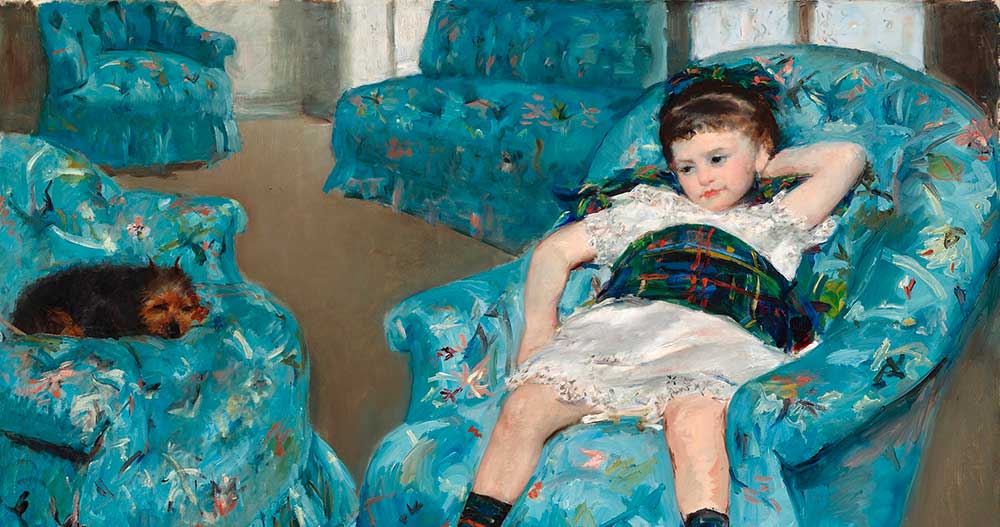
In this piece, it is possible to track Cassatt’s enthusiastic embrace of the Impressionist style. Her limited palette is vibrant and loud, painted onto the canvas with free, energetic brushstrokes.
The picture plane is angled so that the viewer’s attention is taken to the space behind the girl, to the strange layout of patterned furniture and the French doors, which are heavily cropped. The girl’s pose matches the unplanned arrangement of the inanimate objects in the room; she looks as though she has just flung herself down to rest.
There is a feeling of unease, of restlessness, in both the room and the look of the girl. She is bored, perhaps looking for someone or something to play with. Her careless pose contrasts with the carefully arranged clothes, shoes and bow she is wearing. These elements make this piece revolutionary.
The fact that the scene is unposed and the child is undisturbed set this painting apart from Cassatt’s contemporaries. It is radically removed from the academic and Neo-classical works that were shown at the Salon and considered acceptable art at this time.
2. In the Loge (1878)
‘In The Loge’ formed part of Cassatt’s series set inside the theatre.
What is interesting about this piece, and what makes it one of Cassatt’s most memorable, is the active role of the figure.
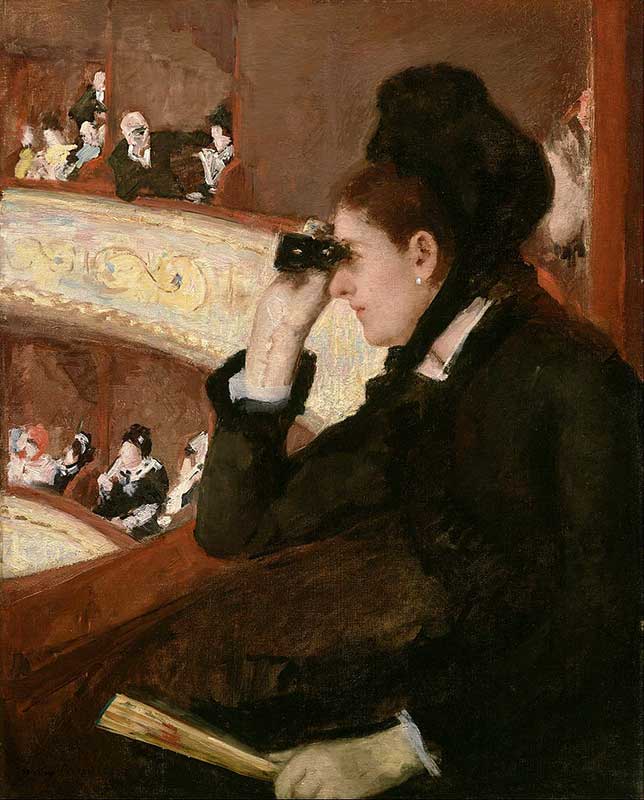
Many of the Impressionists chose to paint women in the contemporary setting of the theatre but few gave them active roles. In contrast, Cassatt’s theatre-goer is engaged in the act of looking, rather than simply just being observed.
In these paintings, Cassatt played with different ways of looking and seeing. This was a dominant theme in avant-garde art as artists wrestled with modern, urban life. More so than ever, people became preoccupied with observing the world around them and it became a pastime in its own right.
This was partly helped by the redesign of the city, which opened up more spaces and venues - think boulevards, cafes, and cabarets - that suited these kind of habits.
This particular piece takes the theme of observation to its extremes. The woman looks through a pair of opera glasses to study the seats across from her. At the same time, a man looks across to her and the viewer looks at both figures.
Hence, Cassatt plays on the act of looking, incorporating the viewer into the piece. The figure’s dark, conservative clothes emphasise the aim of the piece, as do the sketchy faces of the other theatre-goers. This painting is not about decoration, it is about action.
This painting was one of the first Cassatt exhibited in the US. It was met with praise, with critics in Boston in 1878 stating that Cassatt “surpassed the strength of most men.” Another said the piece was “striking.”
Other impressionists, in particular Renoir, produced well known pictures of the theatre.
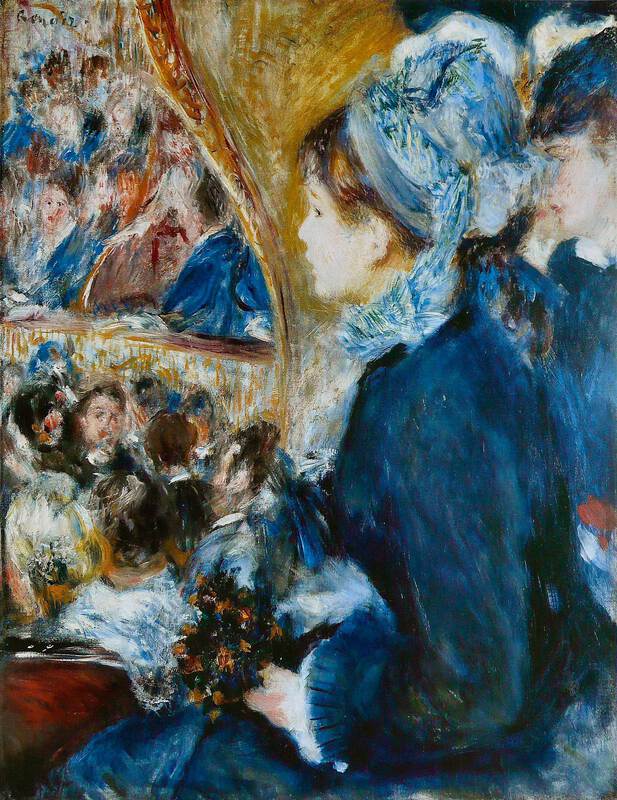
3. Woman with a Pearl Necklace in a Loge (1879)
In the late 1870s, Cassatt embarked on a series of works set in the theatre.
Unlike the work of Degas, these pieces focussed on the spectators rather than the performers.
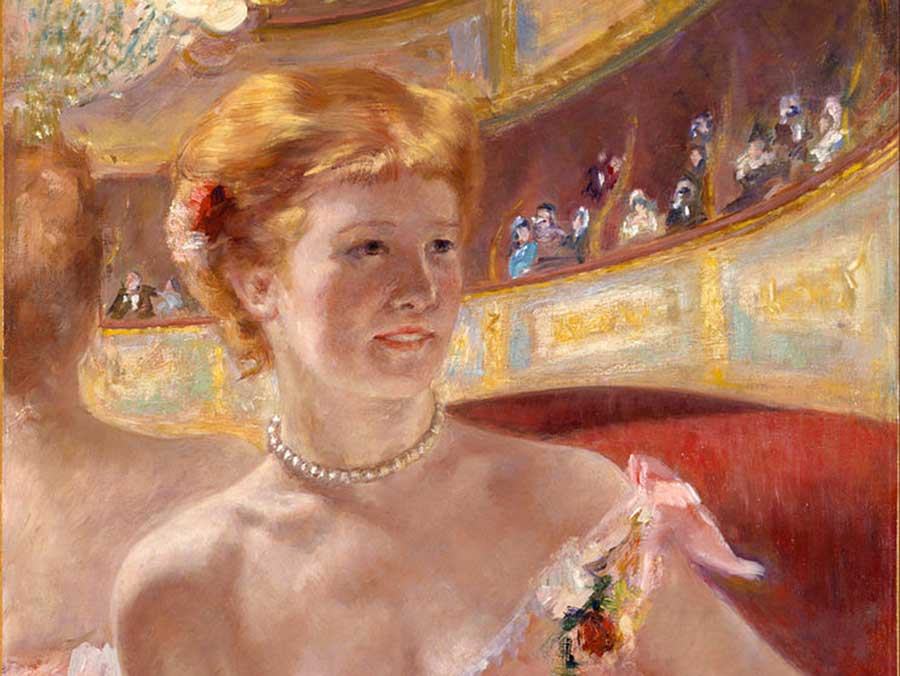
However, she also experimented with the effects of artificial light on the skin of her models.
This particular painting is diffuse with pink tones, from the figure’s flesh to her blushing pink dress, the flowers in her hair and the interior of the theatre.
Cassatt used soft, quick brushstrokes to build up the piece, giving it a uniquely Impressionist style. The model was most likely Cassatt’s sister Lydia.
This painting was exhibited at the Fourth Impressionist Exhibition in 1879. It was praised by many critics and purchased by Alexis Rouart.
Similar works include ‘In the Loge (Corner Box)’ from 1879 and ‘The Loge’ dated between 1878-80.
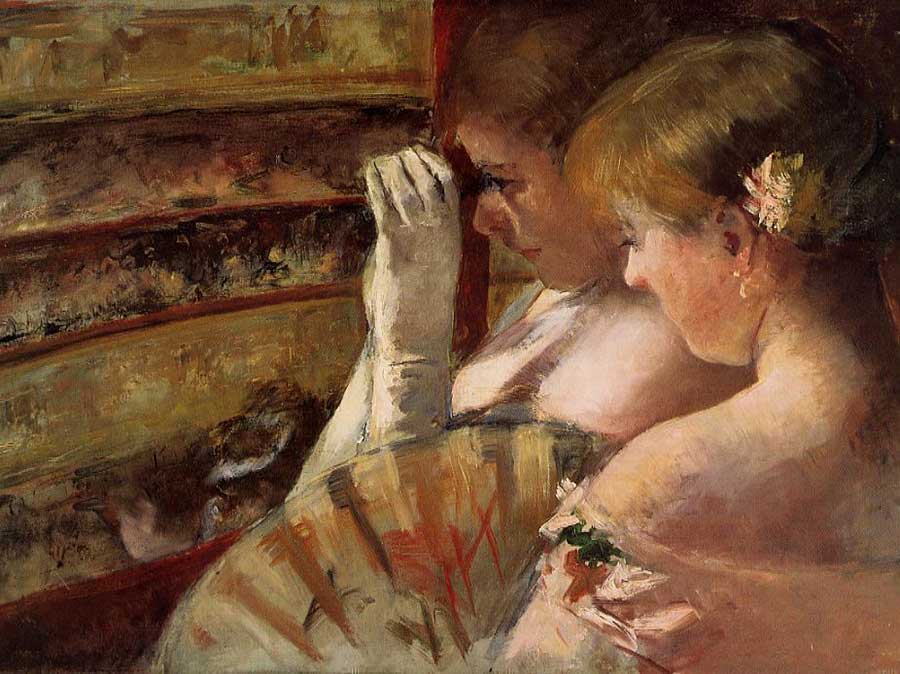
Many of the other works in Cassatt’s theatre series were purchased by Paul Durand-Ruel and sold on to private collectors.
4. The Cup of Tea (1880-81)
Cassatt painted a number of works surrounding the ritual of drinking tea.‘
The Cup Of Tea’ is one of a series of paintings, featuring a young woman holding a delicate china cup and saucer and sat in a large armchair.
The figure, modelled by Cassatt’s sister Lydia, is fashionably dressed in a flouncy pink dress, bonnet and gloves. Her clothing indicates that she has just stepped in from outside and is most likely visiting a friend.
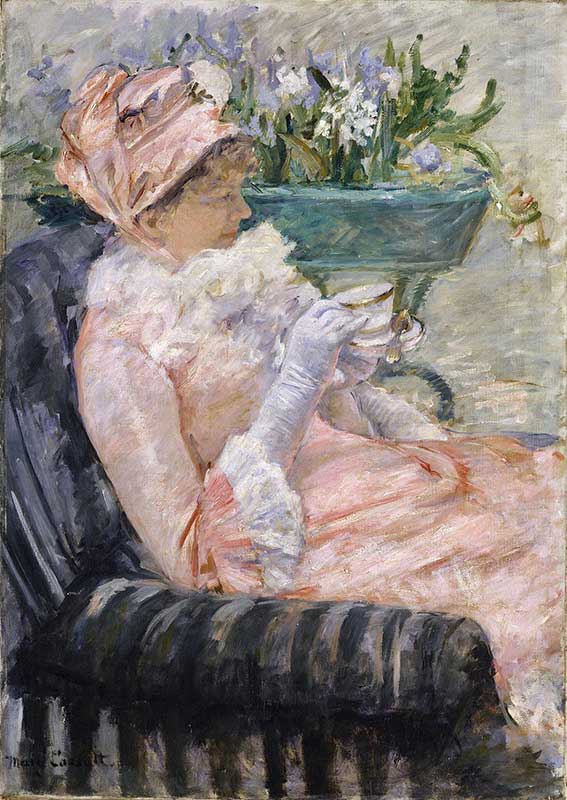
This fashion was typical of upper-middle-class women during the latter half of the 19th century and afternoon tea was an important social ritual for the women who moved in such social circles.
By painting this scene, Cassatt stayed true to the Impressionists’ commitment to paint ordinary life. At the same time, she chose a subject that was unique to her own social context.
Other works in the series include ‘Lady at the Tea Table’ (1883-85) featuring an older woman seated with an elegant gilded blue and white Canton porcelain tea set let out in front of her. ‘Le Thé’ is another notable work, depicting two women drinking tea in a contemporary drawing room.
‘The Cup of Tea’ is painted in a typical Impressionist style, with rough, visible brushstrokes that give an impression of immediacy. The palette draws on contrasting complementary colours.
As F.E.Wissman describes:
“The fresco-like aspect of Cassatt’s works testifies to the emerging concern with the decorative and with decorative schemes in general in the 1880s and 1890s. One wonders if Gauguin was attempting a similar effect […] Large, easily distinguished shapes, a planar organization, shallow space, a generally cool palette, and an even light that abolishes most shadows combine to produce an effect of calm and repose.”
There is certainly an air of tranquility and quiet in Cassatt’s afternoon tea series.
5. Lilacs in a Window (1880-83)
One of the few still life works Cassatt painted during her career, ‘Lilacs in a window’ is a vibrant and lively work.
With fluid brushstrokes she captures the bright purple of the blooms and the lush foliage, echoed by the plants growing beneath the windowsill.
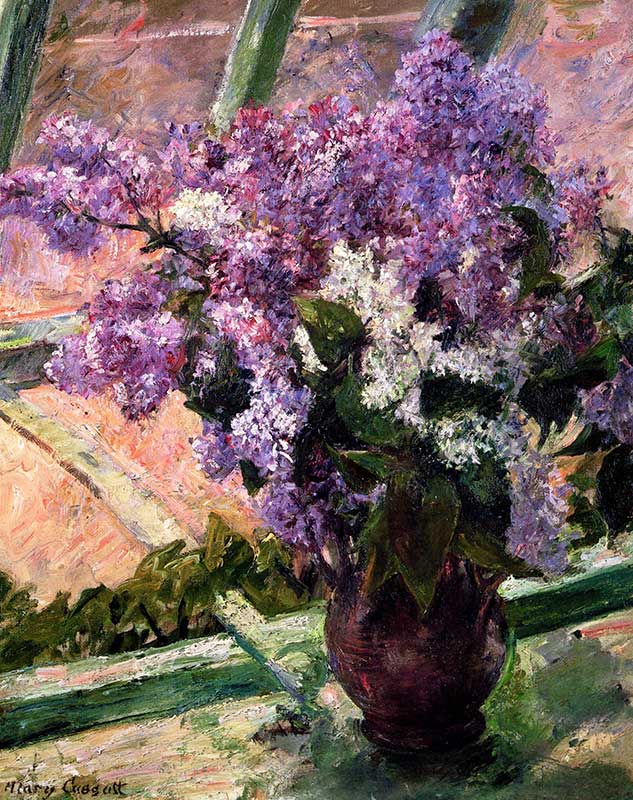
The addition of the window frame in this composition, help open by a wooden prop, adds an angular aspect that offsets the curves of the flowers. The piece feels casual, as though the vase was just set down in its position by a member of the household.
Cassatt utilises the natural, spring light coming from the window and emphasises the strong contrast between light and shadow in the piece.
Floral still lifes became more popular among the Impressionists in the 1860s and there were examples shown in the Impressionist exhibitions of 1874 and 1886.
However, they came into their own in the 1880s as the Impressionists moved towards greater experimentation with colour. Though these indoor paintings were often secondary to the pursuit of plein air works, they were nonetheless a consistent feature in the Impressionist exhibitions.
The original owner of ‘Vase de Lilas a la Fenetre’ was Moyse Dreyfus, a friend of Cassatt’s and collector of her works. Dreyfus also sat for a portrait by Cassatt in 1879.
6. Children Playing on the Beach (1884)
As Cassatt’s reputation grew, she became very well known for her ability to paint mothers and children.
Her innocent, contemporary portraits were extremely popular. This was partly thanks to the naturalness of the works.
‘Children Playing on the Beach’ is no exception. This painting exemplifies the style for which Cassatt was known, borrowing from her interest in Japanese prints and printmaking to inform her composition.
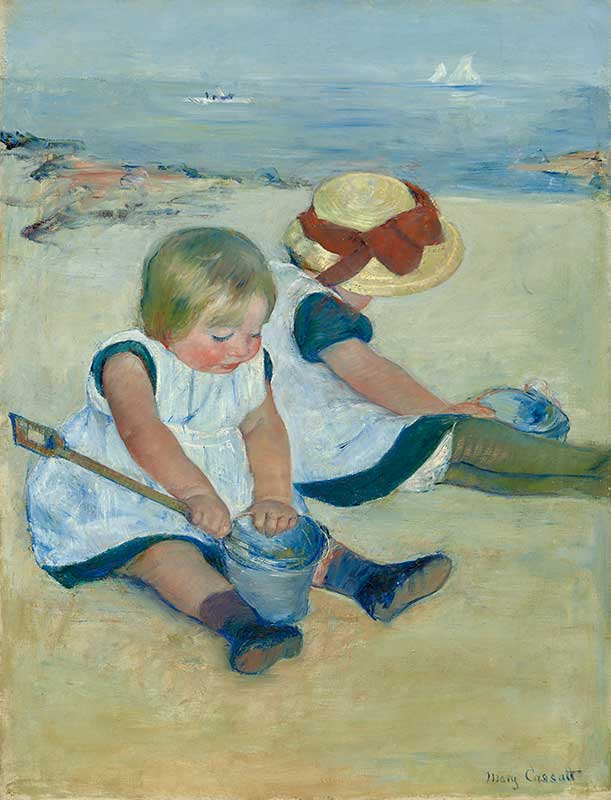
The scene is closely cropped, focussing on the children playing. The angled plane of the picture and the minimalism of the scene places all the emphasis on the young girls.
Cassatt utilised a broad palette of blues to build up the piece, ranging from softer to harder shades for the different elements. To capture the bright sunlight, she adds white touches to the dresses, hats and buckets.
This piece was shown at the eighth impressionist exhibition of 1886, where it was met with praise. As one critic described Cassatt’s work:
"Oh, my God! those babies! How those portraits have made my flesh crawl, time and again!—A whole passel of English and French smearers has painted them in such stupid, pretentious poses! […] For the first time, thanks to Mlle. Cassatt, I have seen effigies of enchanting tots, calm and bourgeois scenes, painted with an utterly charming sort of delicate tenderness.”
It is likely that Cassatt was inspired to paint ‘Children Playing on the Beach’ after returning from Spain with her mother in 1884.
As the primary caregiver to her parents, Cassatt accompanied them as they sought out warmer climates for their health. At the same time, this piece may be in reference to Cassatt’s own childhood with her sister Lydia, who sadly passed away in 1882.
Cassatt was deeply affected by Lydia’s death, so much so that she did not paint for six months afterwards.
7. Girl Arranging Her Hair (1886)
This particular piece supposedly came from a comment made by Degas in which he asked, “What do women know about style?”
Cassatt responded to his dismissive remark by painting a work which centred on the painter’s skill and style. For this painting, she drew on Degas’ own paintings, depicting an ordinary, working-class girl at her toilette.
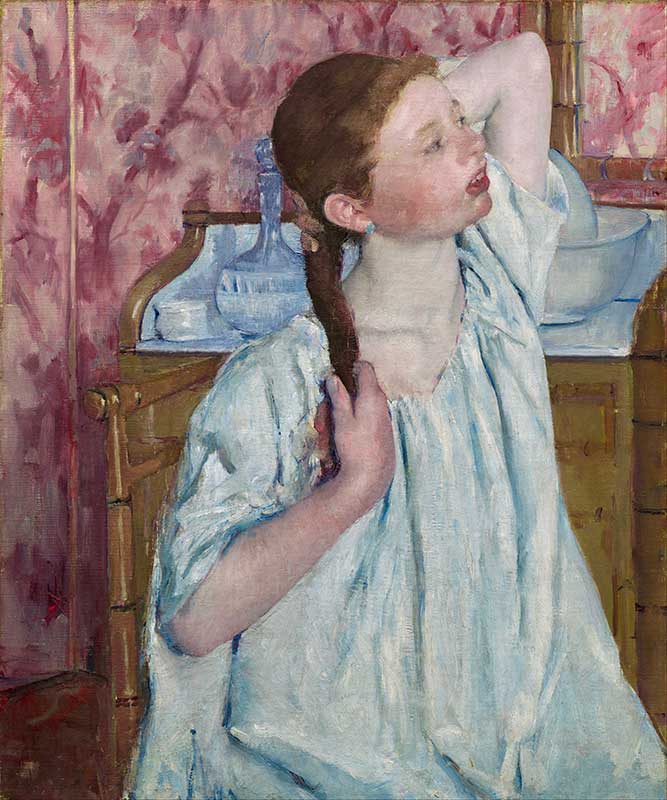
Cassatt paid particular attention to the composition. The viewer’s eye moves through the canvas in a series of steps, echoing the position of the model’s arms.
The chair back, sink and mirror guide the viewer. At the same time, the colours in the painting are carefully chosen to complement one another. The palette of pinks and blues is carried through the wallpaper, the girl’s nightdress and the tones of her skin and lips.
Though this painting is carefully constructed, it also has a spontaneous quality to it. The girl is not flawless or classical in her beauty. There is a realness to her face, her flushed cheeks, slightly open mouth and the awkward pose or her arms.
This piece was exhibited at the Eighth Impressionist Exhibition of 1886. Cassatt and Degas agreed on a swap and he took the painting home and hung it in his private Salon. It was next shown at Paul Durand-Ruel’s ‘Exposition Mary Cassatt’ in 1893.
8. Child in a Straw Hat (1886)
The muted tones in this piece contrast with many of the brighter works Cassatt painted.
Instead, the emphasis is placed on the child’s face and expression, which is somewhat melancholy.
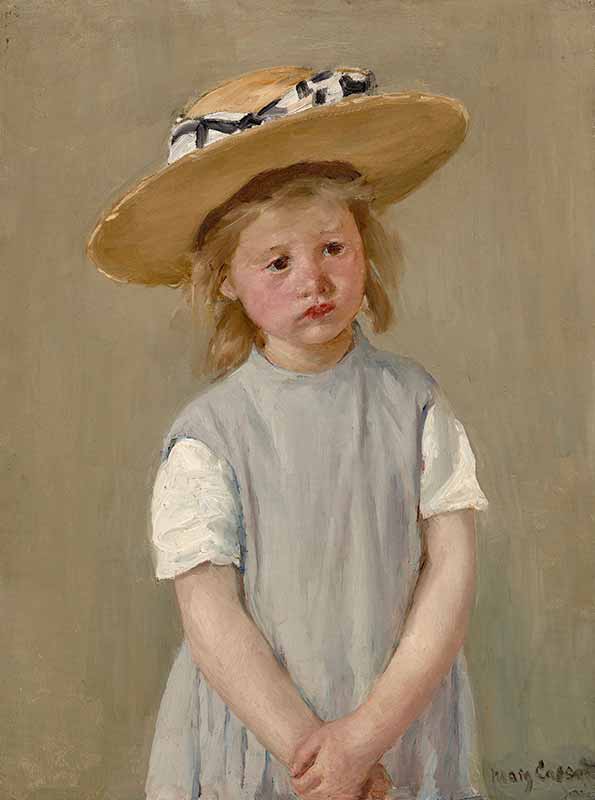
This is one of a large number of paintings Cassatt made featuring children who are playing at dressing up. The image that she captures in this particular piece is less of enjoyment and more of isolation or frustration.
One of the aspects that made Cassatt’s work so memorable was her ability to capture fleeting, ordinary moments in the lives of mothers and children. In her portraits of children, the figures are unconscious and their actions are unexceptional. This gives them a vitality and life, which is enhanced by Cassatt’s painting technique.
Drawing on the Impressionist style, Cassatt used quick, broad brushstrokes to build up the colour in the painting. In this piece, the paint was applied directly onto the canvas, giving it a rougher and more dynamic feel.
Anne Green suggests that it is not just the visible brushstrokes that make this piece feel modern. It is the simplicity of the piece, which opens up the viewer to an empathetic relationship with the child. The face staring out from the painting, with no other context or narrative, demands an emotional reaction.
9. The Boating Party (1893-4)
This striking piece is unusual in Cassatt’s oeuvre.
While many Impressionist artists explored boating scenes and waterside settings for their paintings, Cassatt tended to paint indoors. ‘The Boating Party’ sees her venture onto the water to paint this bold, bright piece.
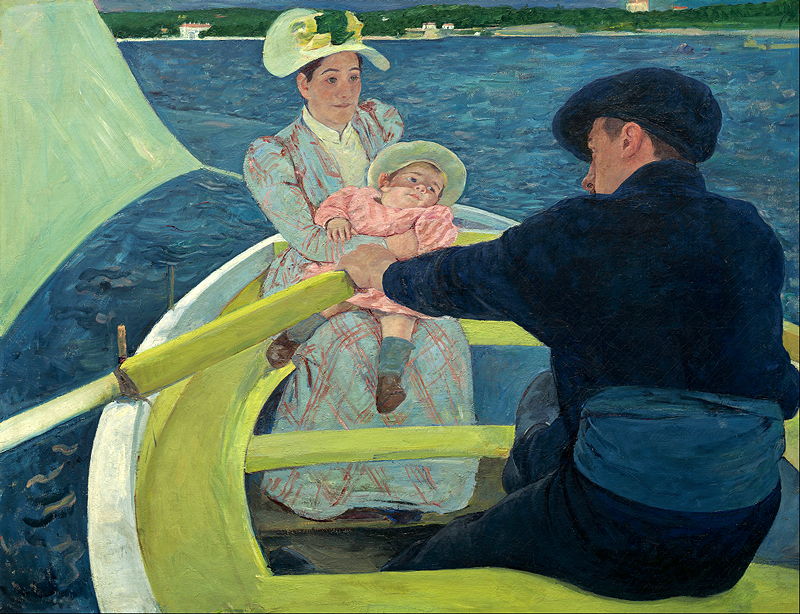
For the composition, Cassatt drew on Japanese prints. Much of her work took inspiration from the Japonisme sweeping Europe during this period and Cassatt experimented heavily with her own Japanese-inspired woodcuts.
This painting echoes the flattened surfaces and simplified colour palette of Japanese art.
It is arguably one of Cassatt’s most ambitious works. The piece is dramatically cropped and the perspective is angled in such a way that the figures appear flattened, whilst the horizon is at the very top of the canvas. The use of intense colours in the piece seems to separate the composition into abstract shapes and the geometric forms of the boat are heightened by this effect.
This piece demonstrates Cassatt’s experimentation with Post-Impressionist techniques, aligning her with artists like Paul Gauguin and Vincent Van Gogh.
It is perhaps no surprise that this painting was one of the most important works in her first US solo exhibition in 1895.
10. Young Mother Sewing (1900)
One of the most dominant themes in Cassatt’s later work is mothers and children.
These paintings are often relaxed, with unconscious poses that give the impression of having stumbled upon a private moment.

Cassatt’s choice of subject matter was partly in response to the restrictions placed on her as a woman in France in the 19th and early 20th century. Nonetheless, in these works she explores themes of intimacy and tenderness, set within the context of contemporary motherhood.
This particular piece was praised for its honesty. As Louise Havemeyer described when she purchased the painting in 1901,
“Look at that little child that has just thrown herself against her mother’s knee, regardless of the result and oblivious to the fact that she could disturb ‘her mamma.’ And she is quite right, she does not disturb her mother. Mamma simply draws back a bit and continues to sew.”
Many of Cassatt’s paintings of mothers and children feature rich colours, with the figures placed within a contemporary setting and wearing casual, fashionable clothing. In her late period, Cassatt developed a fascination for textiles and costume in her work.
This interest is evident from the attention she gives the fabric of the mother’s gown with its unusual linear patterns and the pale folds in the child’s smock.
The model for the child may have been Jules, a boy who Cassatt used frequently as a model in her paintings.





